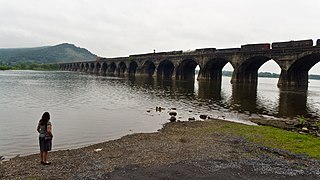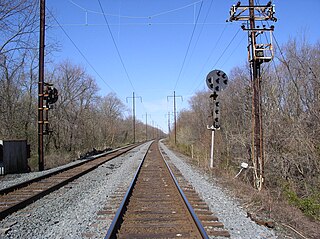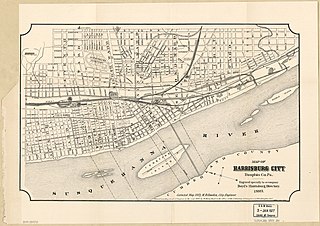Dauphin Narrows Statue of Liberty
On July 2, 1986, a replica of the Statue of Liberty was erected on one of its piers in the Dauphin Narrows of the Susquehanna River. It was made of venetian blinds and stood 18 feet (5.5 m) tall. Six years later, after it was destroyed in a windstorm, it was rebuilt after local citizens raised $25,000 and rebuilt it out of wood, metal, glass and fiberglass, to a height of 25 feet (7.6 m).
It was initially unknown who built the original version, and it remained a local mystery for 25 years until Gene Stilp, a local activist, came forward and admitted to constructing the initial replica. After Stilp came forward, the replica statue was featured on the CBS Evening News in October 2011.

Columbia, formerly Wright's Ferry, is a borough (town) in Lancaster County, Pennsylvania, United States. As of the 2020 census, it had a population of 10,222. It is 28 miles (45 km) southeast of Harrisburg, on the east (left) bank of the Susquehanna River, across from Wrightsville and York County and just south of U.S. Route 30.

Susquehanna Township is a township in Dauphin County, Pennsylvania. The population was 26,736 at the time of the2020 census. This represents a 9.8% increase from the 2000 census count of 21,895. Susquehanna Township has the postal ZIP codes 17109 and 17110, which maintain the Harrisburg place name designation. The township is a suburb of Harrisburg and is connected to Marysville by the Rockville Bridge, the world's longest stone-arch rail bridge at the time of its completion.

The Susquehanna River is a major river located in the Mid-Atlantic region of the United States, overlapping between the lower Northeast and the Upland South. At 444 miles (715 km) long, it is the longest river on the East Coast of the United States. By watershed area, it is the 16th-largest river in the United States, and also the longest river in the early 21st-century continental United States without commercial boat traffic.

The Rockville Bridge is the longest stone masonry arch railroad viaduct ever built, with forty-eight 70-foot spans and a total length of 3,820 feet (1,160 m). The bridge crosses the Susquehanna River about 5 miles (8 km) north of Harrisburg, Pennsylvania. The eastern end is in Rockville and the western end is just south of Marysville.

The Western Maryland Railway was an American Class I railroad (1852–1983) which operated in Maryland, West Virginia, and Pennsylvania. It was primarily a coal hauling and freight railroad, with a small passenger train operation.

The Northern Central Railway (NCRY) was a Class I Railroad connecting Baltimore, Maryland with Sunbury, Pennsylvania, along the Susquehanna River. Completed in 1858, the line came under the control of the Pennsylvania Railroad (PRR) in 1861, when the PRR acquired a controlling interest in the Northern Central's stock to compete with the rival Baltimore and Ohio Railroad (B&O). For eleven decades the Northern Central operated as a subsidiary of the PRR until much of its Maryland trackage was washed out by Hurricane Agnes in 1972, after which most of its operations ceased as the Penn Central declined to repair sections. It is now a fallen flag railway, having come under the control of the later Penn Central, Conrail, and then broken apart and disestablished. The northern part in Pennsylvania is now the York County Heritage Rail Trail which connects to a similar hike/bike trail in Northern Maryland down to Baltimore, named the Torrey C. Brown Rail Trail. Only the trackage around Baltimore remains in rail service.

The Pennsylvania Railroad Bridge once carried the York Branch of the Pennsylvania Railroad across the Susquehanna River between Columbia and Wrightsville, Pennsylvania and is therefore considered a Columbia-Wrightsville Bridge. It and its predecessors were a vital commercial and passenger linkage between Philadelphia and Baltimore for over 100 years.

The Philadelphia & Reading Railroad Bridge carries Norfolk Southern rail lines across the Susquehanna River between Cumberland County, Pennsylvania and Harrisburg, Pennsylvania. Some of its concrete piers encase stone masonry piers from an earlier truss bridge on this site, completed in 1891 by the Philadelphia, Harrisburg and Pittsburgh Railroad, which was then acquired by the Philadelphia and Reading Railroad to connect its Harrisburg and Lurgan lines. The current structure was constructed from 1920 to 1924 by replacing the trusses with concrete arches one track at a time. The bridge has fifty-one concrete arches, three more than the nearby Rockville Bridge.
Hundreds of replicas of the Statue of Liberty have been created worldwide. The original Statue of Liberty is 151 feet tall and stands on a pedestal that is 154 feet tall, making the height of the entire sculpture 305 feet.
The Allentown Railroad was a railway company in the United States. It was incorporated in 1853 with the original intention to connect the Central Railroad of New Jersey at Allentown with the Pennsylvania Railroad's main line across the Allegheny Mountains. Though grading was almost entirely finished, the project was halted by the Panic of 1857, and the completion of the East Pennsylvania Railroad in 1859 made the Allentown Railroad's proposed line largely redundant. As a result, track was never laid on most of the line. The small portion that did became the Allentown branch of the Reading Company from Topton to Kutztown, and was nominally owned by the Allentown Railroad until the Reading dissolved it in 1945 to simplify corporate bookkeeping. Other Reading subsidiaries also laid track on parts of the right-of-way elsewhere along the route. The short line Allentown & Auburn Railroad continues to operate freight service on the Topton to Kutztown route.
The Peach Bottom Railway was a 19th-century 3 ft narrow gauge railroad in Pennsylvania, designed to haul coal from the Broad Top fields in central Pennsylvania to Philadelphia, but succeeded only in establishing two local short lines.

Swatara State Park is a 3,515-acre (1,422 ha) Pennsylvania state park in Bethel, Swatara and Union Townships, Lebanon and Pine Grove Township, Schuylkill Counties in Pennsylvania in the United States. 8 miles (13 km) of Swatara Creek lie within the park's boundaries, which are roughly formed by Pennsylvania Route 443 to the north and Interstate 81 to the south. The park is in a valley in the ridge and valley region of Pennsylvania between Second Mountain (north) and Blue Mountain (south).

The Enola Branch is a railroad segment of the Port Road Branch and was a rail line. The Enola Branch railroad segment and the rest of the Port Road Branch is owned and operated by the Norfolk Southern Railway in the U.S. state of Pennsylvania. The railroad segment runs from Washington Boro northwest to Marysville and it is a former Pennsylvania Railroad rail line. Its south end is at a former junction with the Atglen and Susquehanna Branch, where the main segment of the Port Road Branch continues southeast. Its north end is at the Pittsburgh Line. Along the way, it meets the York Secondary at Wago Junction and goes under the Lurgan Branch at Lemoyne. Norfolk Southern labels the Enola Branch as part of the Port Road Branch, officially ending the Enola Branch's existence as a rail line, the main segment of the Port Road Branch runs from Marysville south to Perryville, Maryland. The line goes through the Enola Yard.

Pennsylvania Route 147 is a north–south route that runs for 58.3 miles (93.8 km) along the east shore of the Susquehanna River in central Pennsylvania, United States. The southern terminus is at an interchange with U.S. Route 22 /US 322 in Reed Township. The northern terminus is at an interchange with Interstate 80 (I-80) and I-180 in Turbot Township.

Eugene Paul Stilp is the 2014 Pennsylvania 104th district House of Representatives candidate, running on the Democratic ticket. Stilp is well known for opposing the 2005 Pennsylvania General Assembly pay raise and his combined use of targeted legal action and creative media-generating props to achieve political change in Pennsylvania. He was born in Wilkes-Barre.
Rockville is an unincorporated community in Susquehanna Township, Dauphin County, Pennsylvania, in the United States. The community is home to the Rockville Bridge.

The Wilmington Rail Viaduct is a series of fills and bridges, about 4 miles (6.4 km) long, that carries the Northeast Corridor through the city of Wilmington, Delaware, above street level. Constructed between 1902 and 1908, the structure consists principally of fills supported by heavy stone retaining walls, punctuated with plate girder bridges over streets, and augmented by a few sections of brick arch viaduct. Its construction is typical of the Pennsylvania Railroad's architectural practices at the time, and the viaduct has been documented by the Historic American Engineering Record and listed on the National Register of Historic Places. Built by the Pennsylvania Railroad (PRR) as part of a series of grade crossing eliminations along the Northeast Corridor, the elevation of the rail line necessitated several other changes to rail infrastructure in Wilmington, including the construction of the Wilmington Shops at the east end of the viaduct, and the construction of the Wilmington Station and adjacent Pennsylvania Railroad Office Building along the elevated right-of-way.

The Buffalo and Susquehanna Railroad was a railroad company that formerly operated in western and north central Pennsylvania and western New York. It was created in 1893 by the merger and consolidation of several smaller logging railroads. It operated independently until 1929, when a majority of its capital stock was purchased by the Baltimore and Ohio Railroad. At the same time, the B&O also purchased control of the neighboring Buffalo, Rochester, and Pittsburgh Railway. The Baltimore and Ohio officially took over operations of both roads in 1932.

The Columbia and Port Deposit Railroad (C&PD) was a railroad that operated in Pennsylvania and Maryland in the 19th and early 20th centuries. It operated a 34-mile long (55 km) main line between Columbia, Pennsylvania, and Port Deposit, Maryland, generally along the eastern shore of the Susquehanna River. It later acquired a branch line to Perryville, Maryland. The C&PD was subsequently purchased by the Pennsylvania Railroad (PRR) and, since the 1999 breakup of Conrail, is owned by Norfolk Southern Railway.

This is a timeline of the major events in the history of Harrisburg, Pennsylvania and vicinity.


















